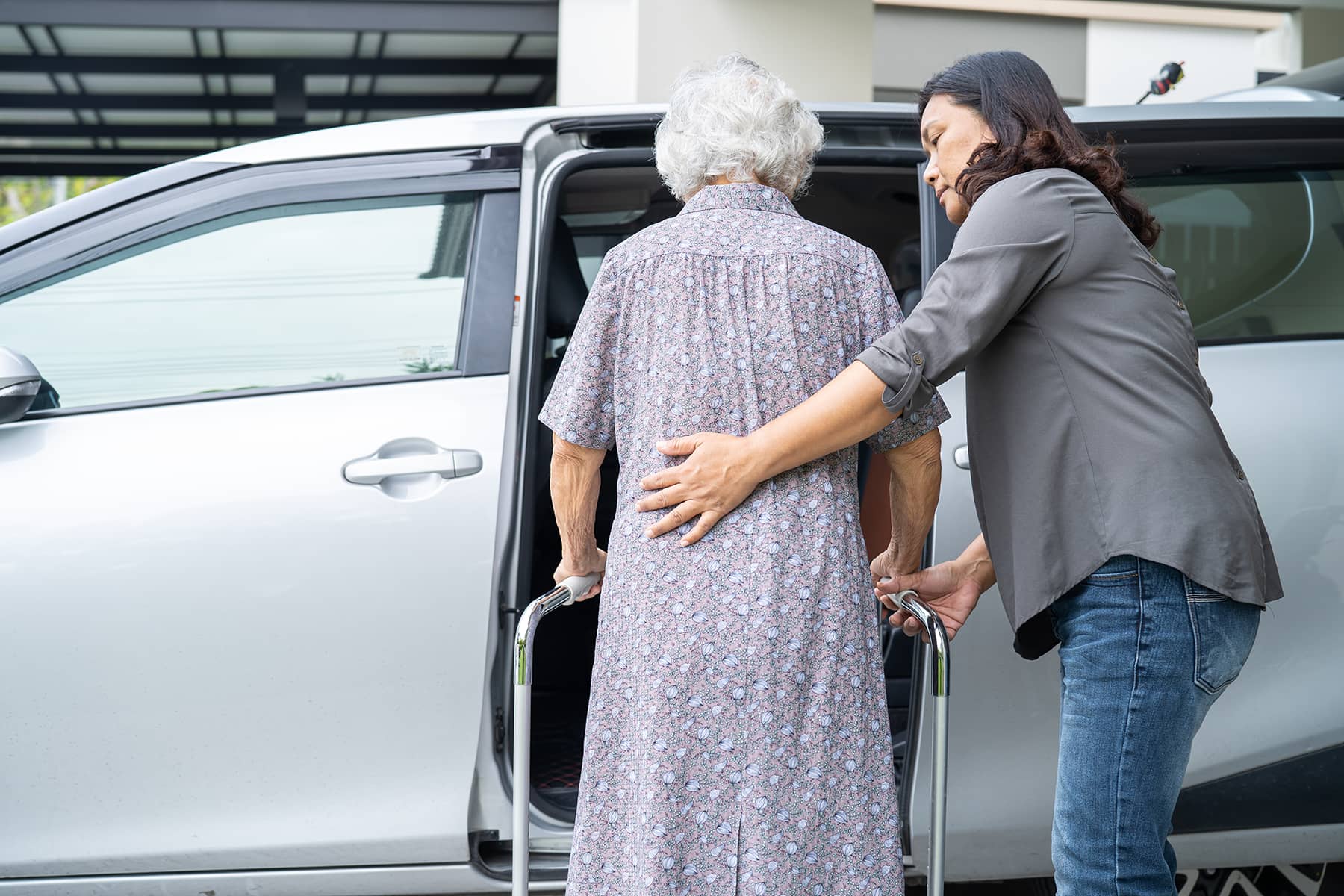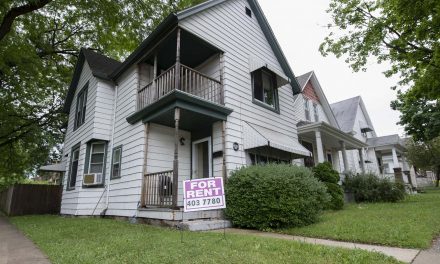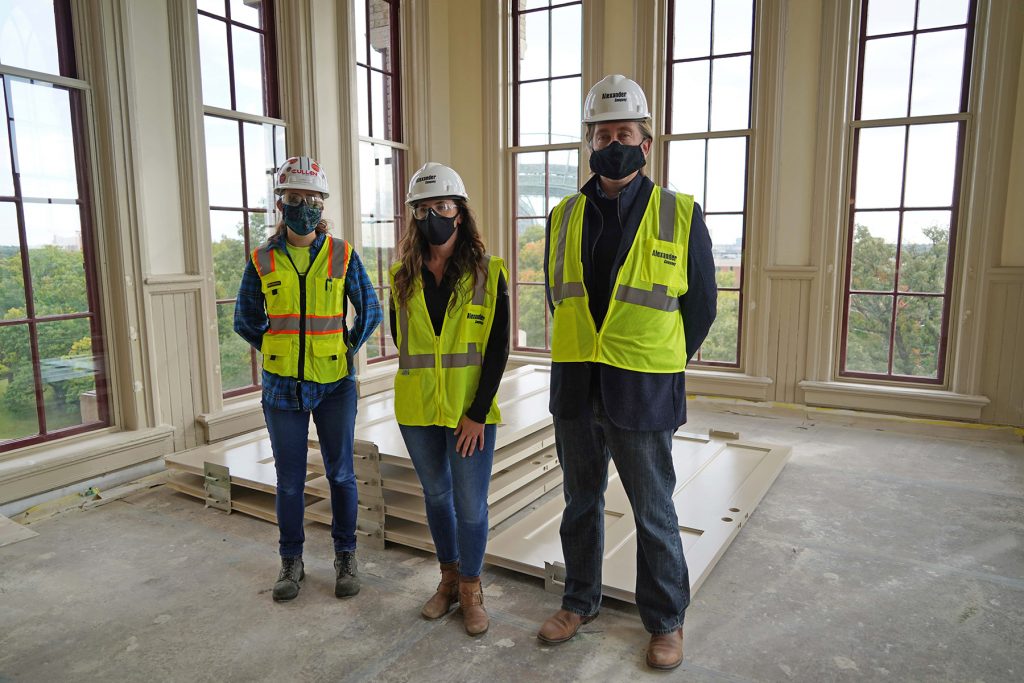
On an unseasonably warm October morning in northeastern Wisconsin, Steve Maricque crisscrosses Brown County in a gray minivan. Orange-red foliage draws the gaze of passengers as overnight rain gives way to clear skies.
A smart tablet guides Maricque along his route. A dispatcher occasionally radios in a request for another pickup, which he adds to his queue when there’s time.
“This first guy had heart surgery, and he’s doing rehab,” Maricque said as he runs through his passenger manifest.
Gregarious and outgoing, Maricque enjoys getting to know passengers. All are elderly or have a medical issue that prevents them from driving. Knowing in advance who needs special assistance, including help getting from their door to the car, can make a ride smoother.
Maricque, 66, is a volunteer driver with the nonprofit Curative Connections, which serves folks with disabilities and the elderly, including transporting them to medical appointments and other important stops. It charges $4 for a one-way trip within a service area that includes Green Bay and surrounding towns and villages.
The nonprofit is part of a fractured transportation system for Brown County’s non-drivers. That includes Green Bay Metro’s traditional busing and door-to-door services in the metro area. Those services will become more important as Brown County’s population, like much of Wisconsin, increasingly skews older and less mobile. But a host of challenges threaten their viability.
Curative Connections, for instance, has lost about half of the drivers who volunteered before the pandemic. The need to pay additional drivers and inflation have strained the nonprofit’s budget and forced service cuts.
Green Bay Metro, like public transit systems across Wisconsin, faces a years-long slide in ridership and revenue that only worsened as remote work options expanded during the pandemic. In August 2020, the transit system launched an on-demand micro-transit service, aiming to plug gaps in its fixed-route service. The new service complements the transit agency’s pre-existing paratransit program for residents with disabilities.
As traditional bus services struggle, advocates for people with disabilities welcome on-demand options but said they fall short in meeting needs for Wisconsinites who do not drive. An influx of federal pandemic aid should help stabilize Green Bay Metro’s systems, but only temporarily.
“One thing that we are really clearly understanding and accepting is that transportation as a whole has changed since the pandemic,” said Patty Kiewiz, Green Bay Metro transit director.
Getting around in graying Wisconsin
Maricque is a life-long Brown County resident. After retiring from the Bellin Health Foundation in October 2021, he immediately volunteered to drive for Curative Connections.
Destiche said his wife previously drove him to cardiac rehab, but back problems now limit her mobility. Destiche’s heart issues prevent him from driving, he explains, but he’s pleased with the service from Curative Connections.
“They do a great job,” he said. “You can’t ask for better, (the drivers) drop you off at the door and pick you up at the door.”
As a retiree, Destiche is part of a growing demographic in Brown County that is more likely to need help getting to doctor’s appointments, work or social events.
Brown County’s population of residents 65 and older topped 42,000 in 2021 — increasing roughly 50% from 2010, according to the U.S. Census Bureau.
The trend is unfolding across Wisconsin as Baby Boomers age and birth rates remain low. The state Department of Administration expects the population of 65-plus Wisconsinites to grow by nearly 500,000 by 2040 and comprise nearly a quarter of the total population, up from 14% in 2010. That’s based upon the agency’s most recent analysis of census data in 2013. Nearby family members can shuttle around some seniors, but that’s hardly the case for everyone.
“A lot of the elderly in the area — nowadays their kids move away and they don’t have someone to get them to where they need to go,” Maricque said. “My parents were fortunate that their kids, three out of the five, lived locally, so we could help support them as they aged.”
Unhealthy transportation barriers
At one stop, Maricque hops out of the van to meet Kathy Koch at the front door of the house where she has lived for more than half a century. Gripping a walker, the 79-year-old makes her way down a front porch ramp. Maricque helps her into the van’s back seat.
Koch is heading to the dentist, just a 10-minute trip by car. Without specialized transportation, she would face a range of logistical hurdles. Curative Connections is essentially the “only way I can get around,” she said.
“I need somebody to get me around, and my husband’s been dead for a while. To ask the children it’s difficult, because they all work, and the grandchildren all work,” she explains.
While some younger people with disabilities rely on Curative Connections for rides to work, medical transportation is among the biggest gaps that Curative Connections fills.
A lack of reliable transportation access caused 5.8 million Americans to delay health care in 2017, according to an analysis of National Health Interview Survey data. Seniors, people with chronic illnesses or disabilities, women and people of color faced the highest transportation burdens, the analysis found.
Those barriers may worsen chronic illnesses, long-term health and the psychological impact of isolation.
While distancing policies reduced COVID-19 transmission among vulnerable seniors earlier in the pandemic, they also worsened feelings of isolation. And even before COVID-19, roughly a quarter of older Americans were considered socially isolated, increasing the risks of loneliness and related health issues.
Many of Maricque’s passengers — like Koch — struggle to leave home without assistance. The rides might offer some of their only in-person interactions for a week.
“I love human contact,” Koch said as Maricque pulls up near the door of her dentist’s office and helps her out of the van. “It doesn’t happen very often.”
As Koch slides out of the seat and grabs the handles of her walker, she looks back.
“Every (driver) I get is pretty okay,” she said with a laugh.
They continue chatting as Maricque slides the door closed and helps her into the office.
Home health care shortage affects transportation
Maricque does his best to help their passengers with mobility issues get to and from a vehicle. But liability risks limit how far drivers can extend that help. Maricque’s role begins and ends at the threshold of a passenger’s home. Some people with mobility issues struggle to get a few dozen feet to their doors. That’s where a home health care provider might step in.
But like the rest of the country, Wisconsin faces a critical shortage of long-term caregivers in homes and assisted-living facilities.
“Folks are wanting to stay in their homes longer,” said Mary Schlautman, the information and assistance coordinator with the Aging and Disability Resource Center of Brown County.
That shortage poses a serious transportation challenge for seniors. If someone can’t make it to the door, drivers for Curative Connections, other nonprofits or Green Bay Metro can’t pick them up.
“People need assistance,” Schlautman said. “Somebody to be there to get them to their wheelchair, to the door, and then the transportation provider will load them onto the van or into the vehicle.”
Shifts in services
Earlier in his career, Maricque spent 10 years leading the American Red Cross Northeast Wisconsin Chapter, which serves 13 Wisconsin counties, the Oneida Nation and parts of Michigan’s Upper Peninsula. The Red Cross previously operated a larger version of the Curative Connections transportation model, which Maricque said included nearby Door County.
But leadership change shifted Red Cross’ priorities, prompting the northeast chapter to cut the transportation service in 2015 in favor of “core competencies” like disaster relief, Maricque said.
Maricque recalls fighting to retain the service. Curative Connections, a smaller nonprofit that shares a building with the Green Bay Red Cross chapter, took over the project.
Just a handful of local organizations offer specialized transportation for seniors and people with disabilities, according to the Aging and Disability Resource Center of Brown County. Those services face a host of challenges.
Funding, workforce hurdles
As of late October, Curative Connections was down to about 52 volunteer drivers, about half the pre-pandemic total, said Tina Whetung, director of transportation for the nonprofit. She said many volunteers who left at the start of the pandemic never came back, a trend that played out at volunteer-powered nonprofits nationwide in 2020.
As a result, Whetung estimates the organization provided 30% fewer rides in 2022 compared to 2019.
Trying to offset the drop in volunteers, Curative Connections hired new paid drivers. Those costs and surging gas prices caused a $40,000 budget shortfall, Whetung said. The nonprofit responded by attracting new donations, hiking fees from $3 to $4 and cutting a staff position.
Still, Whetung expected the organization to wind up “in the hole” for 2022.
Green Bay Metro’s pre-existing paratransit service and new micro-transit service function similarly to Curative Connections: Riders call ahead of time, and they’re picked up at a specific location instead of a bus stop.
The service aims to fill gaps after Green Bay’s traditional bus ridership dropped by more than 60% in a recent two-year period — from nearly 1.3 million rides in 2019 to about 495,000 in 2021. That pushed the department to consolidate routes, increasing bus frequency but limiting range, Kiewiz said.
“One of the things that we’re always wanting to do is to expand services and reach areas that we’re not able to,” she said. “That’s a struggle with your traditional fixed-route system. I think looking at other modes of transportation, like on-demand type services, allows us to do that.”
As part of that shift, Green Bay Metro plans to shave hours off its Monday to Saturday service in 2023. “GBM on Demand”, Green Bay Metro’s micro-transit service, would expand to cover that gap.
Solutions sought for non-drivers
While useful in certain situations, government-operated on-demand services remain imperfect, said Tamara Jackson, public policy analyst and legislative liaison for the Wisconsin Board for People with Developmental Disabilities and a co-chair of the state’s Non-Driver Advisory Committee.
“There is no silver bullet here. There are a number of places that are trying to do on-demand service, and I think that gets at some challenges people have,” she said. “But it doesn’t necessarily solve some of the regional challenges and land use planning challenges that impact non-drivers.”
Some passengers struggle with affordability and scheduling, Jackson said. And many on-demand services struggle in rural areas and operate in a limited range.
Green Bay Metro’s on-demand services run during limited hours and operate mostly within the boundaries of its busing area. Curative Connections operates throughout Brown County but centers operations in and around Green Bay. It seeks volunteers to add more rural services, said Whetung.
Slipping bus ridership, revenue
Wisconsin’s local transportation systems face a difficult financial future. The state’s nine largest metro transit systems, including Green Bay’s, saw ridership plummet from 48.5 million in 2019 to 22.6 million in 2021.
While transportation officials largely blame the pandemic for that drop, ridership began declining more than a decade earlier. The nine systems provided 72 million rides in 2007, according to the nonpartisan Wisconsin Policy Forum.
Declining gas prices, a strong economy, the rise of app-based ride-sharing, reduced transit service and the shift to working from home decreased ridership, according to a 2021 Wisconsin Legislative Fiscal Bureau report.
Meanwhile, the state is investing less in local transit projects. Excluding special funding for paratransit and tribal transit, the state spent about $72 million in mass transit operating aid in 2022 — nearly 40% less than in 2021. It’s the lowest funding level in more than a decade.
The state uses separate pools to fund transportation for older residents and those with disabilities. The largest pool flows to county governments. At $16 million, it’s higher than a decade ago ($13.6 million) but stagnant since 2019.
Kiewiz said new federal infrastructure funding and pandemic aid has filled some gaps. But it’s not a perfect fix.
“I think the next few years here, we’ll be in a much better position than we have been,” she said. “But you know, that’s also something you need to be careful of. That’s really kind of one-time money. What are we going to do in a couple of years?”
Wisconsin’s Non-Driver Advisory Committee, established in 2020 and coordinated by the Department of Transportation, is considering measures to gauge how well communities address non-driver needs.
“This is the beginning of a long conversation about how (we’re) thinking about transportation for people who are not necessarily drivers,” Jackson said.
‘I see the impact’
Maricque sits at a table in the Curative Connections main office as other volunteers and staff members buzz around him. He sees himself as more than just a driver.
“I see the impact every time I drive on the individuals I’m serving,” he said.
His aim to serve the community guided his work at the Red Cross and Bellin Health and prompted him to volunteer with Curative Connections just days into his retirement.
“I’ve learned that there are life lessons you learn from the elderly,” he said. “It gives me fulfillment to be able to understand their stories and to be able to help them continue to lead as much of a normal life as they can.”
Jonah Chester
Sasirin Pamai
Originally published by wisconsinwatch.org
The nonprofit Wisconsin Center for Investigative Journalism collaborates with Wisconsin Public Radio, Wisconsin Public Television, other news media and the UW-Madison School of Journalism and Mass Communication. All works created, published, posted or disseminated by the Center do not necessarily reflect the views or opinions of UW-Madison or any of its affiliates.














